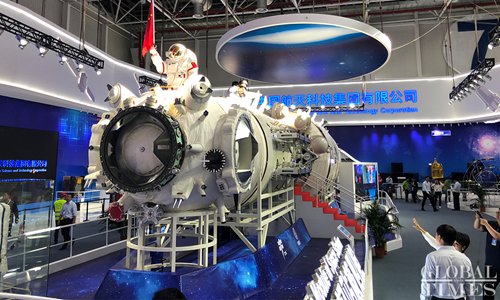HOME >> CHINA
New plan stresses high tech
By Deng Xiaoci and Chen Qingqing Source:Global Times Published: 2020/1/7 22:38:40
‘Those in need raise problems, sci-tech circle finds solutions’

Replicas of China's manned launch vehicles, space station core modules, new generation of carrier rockets and other spacecraft were debuted at Air Show China 2018. Photo: Yang Sheng/GT
China unveiled its ambitious five-year plan for national key projects focused on fundamental and frontier sciences, urging major breakthroughs in core technologies, especially those related to national security and essential competitiveness amid an imminent China-US tech war and possible decoupling.The Ministry of Science and Technology (MOST) issued a notice to kick-start a new round of research and development (R&D) demand solicitation for key national projects in the country's upcoming 14th Five-Year Plan (2021-25), according to a statement published on its website on Monday.
The new development plan, compared to previous national key projects during the 13th Five-Year Plan period (2016-20), included new domains such as information technology (IT) and space technology, urging China's science and technology sphere to make major breakthroughs in technologies related to national security and enhancing core competitiveness.
It also gives a hint into the country's future R&D focus as the US-China rivalry expanded into high-tech sector, observers said.
The Chinese tech industry experienced a rough 2019, as a trade war between China and the US has been evolving into a tech war, with Washington escalating its crackdown on the rising tech power of the world's second-largest economy.
Most recently, the US government took measures to limit exports of artificial intelligence software to China, which is also part of its broader efforts to restrict sensitive technology cooperation with its adversaries like China over economic and national security reasons.
"Considering the trade war and tech competition, China has been significantly valuing fundamental frontier research - for example, IT industry, fundamental materials and chipsets, to which Chinese authorities have now attached unprecedented importance," Xiang Ligang, director-general of the Beijing-based Information Consumption Alliance, told the Global Times on Tuesday.
The MOST's solicitation covers major strategic foundation frontiers, as well as fields like energy, transport, manufacturing, material and space technologies.
The new round of science and technology revolution and industrial revolution are picking up pace, the MOST said. And major breakthroughs have been bred from basic frontier fields.

A visitor tries out 5G VR equipment at the China International Big Data Industry Expo held in Zunyi, Southwest China's Guizhou Province, in May. Photo: VCG
"Each fundamental area mentioned [in MOST's next five-year development plan] is highly crucial, based on which major technology breakthroughs could be made," Xiang said.
"For example, from research on fundamental materials, R&D projects could cover chipset materials, space shuttle and deep-sea vehicle materials."
The severe US crackdown on Chinese tech firms such as Huawei and ZTE had driven China to strengthen its tech infrastructure and to build self-sufficient supply chains, with some even carrying out a de-Americanization campaign to reduce reliance on core components from the US.
And in the 14th Five-Year Plan road map, the MOST urged greater focus on self-reliance and innovation and to work on existing shortcomings, which had not been mentioned in the previous five-year plan.
China's deficiency
Guo Guoping, an expert on quantum computer development from Hefei-based University of Science and Technology of China, told the Global Times on Tuesday that he had already applied for a semiconductor quantum chip research to the ministry.
It's clear China has been accelerating its efforts to catch up with the US in the quantum computing sector, which, however, might lead to more severe measures imposed by the US government to curb China's development, he noted.
"However, I am still confident that China could succeed despite of this, as the country and its scientists and engineers are more determined and the authorities have displayed more patience and interest in industry- and application - oriented research," Guo said.
"Admittedly, there is gap of around five years between China and US in the quantum computing field, and the US import bans on materials and supply chains, such as integrated circuits and software, could affect China's progress in the field," Guo remarked.
While China-US tech decoupling is becoming likely, industry analysts noticed China's urgency in building more competitive technology industry and supply chains.
However, how far China could go in some cutting-edge domains without US supply remains a major question.
Changing mind-set
To facilitate the link between R&D and supply chains, the MOST's future plan features the exploration of a new work mechanism, which could be summarized as "those in need raise the problems, and the science and technology circle find the solutions," as the document showed.
Such a mechanism requires applicants to fully describe what their demands are, and how specific innovation could address the current problems or to overcome current development bottlenecks, as well as the strategic importance and urgency of potential projects expected to meet such demands and be applied to different scenarios.
While there is a gap between fundamental research and the application of technologies, some industry representatives expect more capital from society's emerging enterprises to get involved and narrow the gap from purely research-end to the product-end of these concepts, hastening the industrialization process.
Chinese scientists and researchers should also change their mind-sets from going for a pure academic paper to chasing actual applications to their findings, Guo said.